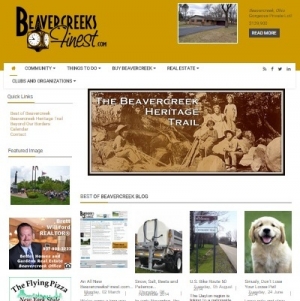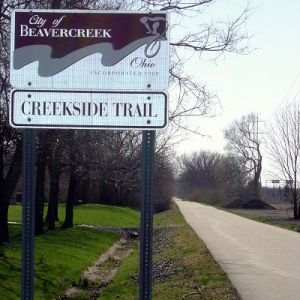
Brett Williford
Re-introducing you to the Beavercreek you love... from 1803 to today!
We've come a long way, baby! Welcome to the latest incarnation of the site! Over the years, BeavercreeksLiving.com has evolved from a clunky news and info project into a mobile-responsive special feature site about the wonderful community we call home.
In early November 2014, the City of Beavercreek Road Department invited members of the press to see how they've prepared for the upcoming winter, and those to come. Being a limited service city, our administrators are continually looking down the road, pun intended, at the newest methods to provide the exceptional service we the citizens demand within the budget that we insist upon.
The Dayton region is linking to a nationwide network of bicycle routes, the first in Ohio designated as U.S. Bike Route 50 from the Indiana border in Preble County to Steubenville on the WV border.
The 1858 Peter Tobias-Zimmer barn is a one-story salt box design with the white oak frame mortised and pinned. It was built by Peter Tobias in 1858 and subsequently owned by The Zimmer Family. From the plain style of the barn, it is thought that the carpenters were Shakers. It came from the area known as “The Big Woods” in Beavercreek. The original siding was vertical white pine with hand-split walnut lap-sided gable ends. All materials came from the farm except the white pine siding.
Originally, it was located in Zimmer Estates on the property of Bob and Agnes Zimmer who donated the barn and moved it in one piece to Wartinger Park in 1996. The barn was used among other things, for threshing. Sheaves of grain (mostly wheat, oats, and barley) were stored in the mow following a short curing time in the shock. During the yearly threshing season, the threshing machine was positioned on the barn floor with the rear barn doors open. Straw was blown on a pile out in the barnyard. After the move, new board and batten siding was added along with a concrete floor. The old metal roof and wood roof shingles were removed and replaced with a new standing seam metal roof.
The barn now contains many demonstration items used by the Beavercreek Historical Society for their Wartinger Park functions.
It was donated by Max Zink to the Flower Trail Garden Club in 1979 and moved to Wartinger Park. Originally located on the southeast corner of New Germany and Grange Hall Roads on property which was owned by the Zink family. The Zink family had moved there in 1932. For many years, the home was rental property , then it stood empty. Finally, the Board of Health issued a close order. In the process of tearing off the weather stripping, the old log cabin was discovered. Research showed that the cabin was built by John Nicodemus in 1811.
The Nicodemus Cabin became the second cabin at Wartinger Park, the first being the Jarusiewic Cabin, both are used by The Flower Trail Garden Club. Stone removed from the cabin’s original foundation was used around the cabin base.
https://beavercreekliving.com/beavercreek-blog/itemlist/user/23-brettwilliford?start=20#sigProId79c695c7f5
This house was originally located on Ankeney Road on the property owned by Mary and Phil Ankeney. It was donated to the Beavercreek Historical Society by them and rebuilt at Wartinger Park in 1993. Samuel Ankeney, age 19, bought the Ankeney House in 1830 along with 210 acres after his father died in 1830, having just arrived from western Maryland. Samuel built a kitchen for his mother and added it onto the house. He was the oldest of ten children.
The cabin was about four years old when Samuel Ankeney bought it from John Davis. The Ankeney House fireplace was rebuilt in 1997 with bricks from the old Beavercreek High School which had burned in 1996.
 Ankeney House Kitchen 1
Ankeney House Kitchen 1
Ankeney House Kitchen 1
Ankeney House Kitchen 1
 Ankeney House Kitchen 2
Ankeney House Kitchen 2
Ankeney House Kitchen 2
Ankeney House Kitchen 2
 Ankeney House Living Room 1
Ankeney House Living Room 1
Ankeney House Living Room 1
Ankeney House Living Room 1
 Ankeney House Living Room 2
Ankeney House Living Room 2
Ankeney House Living Room 2
Ankeney House Living Room 2
 Ankeney House Kitchen 3
Ankeney House Kitchen 3
Ankeney House Kitchen 3
Ankeney House Kitchen 3
 Ankeney House Kitchen 4
Ankeney House Kitchen 4
Ankeney House Kitchen 4
Ankeney House Kitchen 4
 Ankeney House Plumbing
Ankeney House Plumbing
Ankeney House Plumbing
Ankeney House Plumbing
 The Early Oven/Stove
The Early Oven/Stove
The Early Oven/Stove
The Early Oven/Stove
https://beavercreekliving.com/beavercreek-blog/itemlist/user/23-brettwilliford?start=20#sigProId69858c2753
The Jarusiewic Cabin (c. 1805) was discovered in April 1972 on North Fairfield Road. In 1972, Beavercreek resident George Jarusiewic owned the property, and his restaurant was named Scotties. George Jarusiewic wanted to preserve the old house for Beavercreek. The house was dismantled, meticulously, and rebuilt at Wartinger Park by George Jarusiewic.
In the spring of 1997, the 16 by 24-foot structure was removed from the park by the Beavercreek Parks, Rec. and Culture Dept because of insect infestation. Only the fireplace was salvaged. Brady Kress, Executive Director of Dayton History made the replica, authentic to the period. Ten tons of stone made the stone fireplace from a cabin located on Sperling Lane in Beavercreek.
The Philip Harshman house (c. 1803-1807) was discovered in 1985 when a wood-sided two-story house, which was originally located just south of St. Luke Catholic Church on North Fairfield Road, was condemned and slated for demolition. When the wood siding was removed, the original log house was revealed. An effort was quickly begun by a group of local citizens, that later became the Beavercreek Historical Society, to save the historic structure for restoration. The stone pathways to the Harshman House kitchen garden as well as those leading to the Ankeney House are limestone rocks which were saved from the foundation of the old Lantz Barn on Kemp Road.
https://beavercreekliving.com/beavercreek-blog/itemlist/user/23-brettwilliford?start=20#sigProId4fecc2fc5e
Turn east on Lakeview Drive and follow around to the right.
Perched on a hill at 2381 Old Home Court is the stately Tobias–Zimmer House, built in 1859 by Peter Tobias. The land was originally deeded to Jesse Hunt via a land grant and subsequently divided. It was so densely wooded that it became known as “The Big Woods”. An early schoolhouse was built in 1839 on a half acre of land donated by then owner, Henry Ankeney. The limestone front step and school bell can still be seen in the front yard! The Shaker construction features hand hewn, mortised and pinned white oak frame construction with walnut woodwork.
In 1950, Bob Zimmer purchased the 103 acre farm from the Batdorf family, which ran Miami Valley’s largest turkey farm onsite in the 1940’s.
Latest Blog Posts
- Just Don't Call Us Late For Dinner...
- Remember When...
- What A Long, Strange Trip It's Been...
- Snow Down = Slow Down
- School Bus Safety - Just Do It!
- Stevenson Road Covered Bridge
- Our Road Crews Are Worth Their Salt!
- The Most Colorful Of Seasons!
- Popcorn Fest! - Then And Now
- Pre-School Paradise!
- Remembering Riffles
- Ten Year Anniversary Of The Beaver Statues














